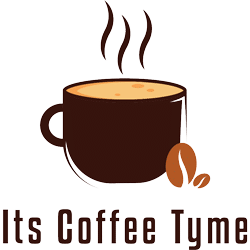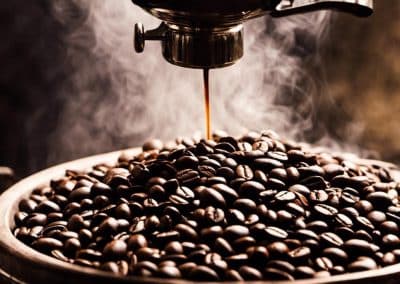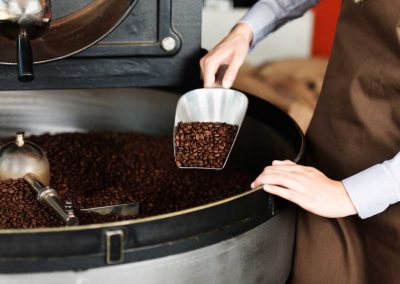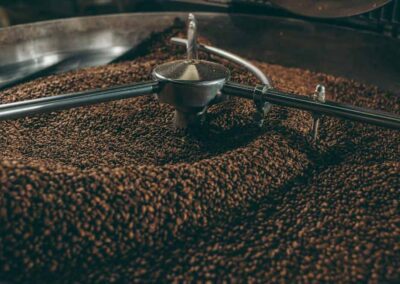Small batch coffee roasting has become increasingly popular among coffee enthusiasts in recent years. This method involves roasting coffee beans in small quantities, typically between 5-20 pounds at a time. The process is more time-consuming and requires more attention to detail than large-scale roasting, but it allows for greater control over the final product.

One of the main advantages of small batch coffee roasting is the ability to achieve a more consistent and higher quality roast. Roasting in smaller batches allows for greater control over the temperature and timing of the roast, resulting in a more even and flavorful coffee. Additionally, small batch roasters often use higher quality beans and take greater care in the roasting process, resulting in a superior product.
If you’re a coffee lover looking to try something new, small batch coffee roasting may be worth exploring. With a growing number of small batch roasters popping up across the country, there are plenty of options to choose from. Whether you’re looking for a unique flavor profile or simply a higher quality cup of coffee, small batch roasting is definitely worth considering.
Understanding Coffee Roasting
Coffee roasting is a process that involves heating green coffee beans to a specific temperature and time, resulting in the transformation of the beans into roasted coffee. This process is crucial in determining the flavor profile of the final product. In this section, we will discuss roast profiles, processing methods, and roasting times.
Roast Profiles
Roast profiles refer to the degree of roasting that coffee beans undergo. The degree of roast can range from light to dark, with each level having a distinct flavor profile. Light roasts are roasted for a shorter period and have a light brown color with a sour taste. Medium roasts have a darker brown color and a balanced flavor profile. Dark roasts have a dark brown color and a bitter taste.
Processing Methods
Processing methods refer to the way coffee beans are processed after they are harvested. There are three main processing methods: washed, natural, and honey. Washed processing involves removing the outer layers of the coffee cherry before drying the beans. Natural processing involves drying the whole coffee cherry before removing the outer layers. Honey processing involves partially removing the outer layers before drying the beans.
Roasting Times
Roasting times refer to the duration of time that coffee beans are roasted. Longer roasting times result in darker roasts and a more intense flavor profile. Shorter roasting times result in lighter roasts and a milder flavor profile. The roasting time is dependent on the roast profile and the processing method used.
In summary, coffee roasting is a complex process that involves different roast profiles, processing methods, and roasting times. The flavor profile of coffee is influenced by these factors, and it is essential to consider them when roasting coffee beans.
Small Batch Roasting
Small batch roasting is a method of roasting coffee beans in small quantities, typically less than 50 pounds at a time. This method of roasting is gaining popularity among specialty coffee roasters due to its ability to produce consistent roasts and maintain quality control.
Quality Control
Small batch roasting allows for a level of quality control that cannot be achieved in larger batches. Roasting small batches of coffee allows the roaster to closely monitor the roast and make adjustments as needed to ensure a consistent and high-quality product. This level of care and attention ensures that each batch of coffee is roasted to perfection, resulting in a superior cup of coffee.
Advantages of Small Batches
There are many advantages to small-batch roasting. One of the primary benefits is that it significantly reduces the time between roasting and packaging to be shipped. This means that the coffee beans are as fresh as possible when they arrive at the consumer’s doorstep. Additionally, small-batch roasting allows for greater flexibility in terms of options and size. Roasters can experiment with different blends and roast profiles without committing to a large batch.
Small-batch roasting is also beneficial for those who are looking to roast their own coffee at home. There are many small-batch coffee roasters available that are perfect for at-home roasting. The Behmor 2000AB Home Coffee Roaster, for example, allows users to roast up to 1 pound of beans with its 5 pre-programmed roast settings and manual time, temperature, and drum speed settings.
Overall, small-batch roasting is a great way to ensure that your coffee is as fresh and high-quality as possible. Whether you are a specialty coffee roaster or an at-home coffee enthusiast, small-batch roasting is definitely worth considering.
Home Roasting
Home roasting is becoming increasingly popular among coffee enthusiasts who want to enjoy freshly roasted coffee from the comfort of their own homes. There are several methods for home roasting, including using a popcorn maker, air roasters, drum roasters, and home coffee roasters.
Home Roasters
Home coffee roasters are specifically designed for roasting coffee beans at home. They come in various sizes and types, including electric and manual models. Some popular models include the Fresh Roast SR540, Kaldi Home Roaster, and Jiawanshun Electric Coffee Roaster. Home roasters offer more control over the roasting process, allowing users to adjust the temperature, time, and roast level to their liking.
Roasting Green Beans at Home
To start home roasting, one must begin with green coffee beans. These can be purchased from a variety of sources, including online retailers and local specialty coffee shops. Once the beans are acquired, they can be roasted using one of the aforementioned methods.
When roasting coffee at home, it is important to pay attention to the roast level and the temperature. Different roast levels produce different flavors and aromas, so it is important to experiment to find the desired roast level. Additionally, it is important to cool the beans quickly after roasting to prevent over-roasting and to preserve the flavor and aroma.
Overall, home roasting is a fun and rewarding way to enjoy freshly roasted coffee at home. With the right equipment and knowledge, anyone can become a home coffee roaster.
Types of Coffee
When it comes to small-batch coffee roasting, there are various types of coffee that can be used. Here are two common types of coffee that you can expect to find in small-batch roasting:
Single-Origin Coffees
Single-origin coffees are those that come from a particular country, region, or farm. These coffees are typically known for their unique flavors and aromas, which are influenced by the soil, altitude, and climate of the region where they are grown. For instance, coffee from Guatemala is known for its chocolate and nutty flavors, while coffee from Ethiopia is known for its fruity and floral notes.
Small-batch roasters often specialize in single-origin coffees, as they allow the roaster to showcase the unique flavors of the coffee. Some popular small-batch roasters that specialize in single-origin coffees include Ceremony Coffee Roasters and Blue Bottle Coffee.
Specialty Coffees
Specialty coffees are those that have been graded and scored by a professional taster, according to the Specialty Coffee Association’s (SCA) standards. These coffees score 80 points or higher on a 100-point scale, and are known for their exceptional quality and unique flavors.
Small-batch roasters often specialize in specialty coffees, as they are passionate about sourcing and roasting the best coffee possible. Some popular small-batch roasters that specialize in specialty coffees include Counter Culture Coffee and Intelligentsia Coffee.
In conclusion, small-batch coffee roasting allows for the use of unique and high-quality coffee beans, such as single-origin and specialty coffees. These types of coffees offer a unique and flavorful experience that is not often found in mass-produced coffee.
The Role of the Roastmaster
The roastmaster plays a crucial role in small batch coffee roasting. They are responsible for overseeing the entire roasting process, from selecting the green coffee beans to determining the roast profile and ensuring that each batch is roasted to perfection.
One of the main responsibilities of the roastmaster is to select the right beans for each batch. They must consider factors such as the origin of the beans, the altitude at which they were grown, and their flavor profile. Once the beans have been selected, the roastmaster must determine the best roast profile to bring out the unique characteristics of the beans.
During the roasting process, the roastmaster must closely monitor the beans to ensure that they are roasted evenly. This requires a keen eye and a deep understanding of the roasting process. The roastmaster must also be able to make adjustments to the roast profile as needed to ensure that each batch is consistent.
In addition to overseeing the roasting process, the roastmaster is also responsible for ensuring that the roasting equipment is properly maintained and calibrated. This includes regular cleaning and maintenance of the roaster, as well as ensuring that the temperature and humidity in the roasting room are kept at the optimal levels.
Overall, the role of the roastmaster is essential to the success of small batch coffee roasting. Their expertise and attention to detail ensure that each batch of coffee is roasted to perfection, resulting in a high-quality, flavorful cup of coffee.
Coffee Preparation
Preparing coffee is an essential step in making a delicious cup of coffee. Whether you’re making a hot cup of coffee or a cold brew, the preparation process can significantly impact the strength and flavor of your coffee.
Cold Brew Coffee
Cold brew coffee is a popular choice for coffee lovers who enjoy a smoother and less acidic taste. To make cold brew coffee, coarsely ground coffee beans are steeped in cold water for up to 24 hours. The result is a concentrated coffee extract that can be diluted with water or milk.
To make cold brew coffee, coffee lovers can use a variety of methods, including using a French press, a mason jar, or a cold brew coffee maker. Regardless of the method used, the key to making great cold brew coffee is to use high-quality coffee beans and to steep the coffee for the right amount of time.
Strength and Flavor
The strength and flavor of coffee can be influenced by a variety of factors, including the roast level, the brewing method, and the coffee-to-water ratio. When preparing coffee, it’s important to keep these factors in mind to achieve the desired strength and flavor.
For example, if you prefer a stronger coffee, you may want to use a darker roast or increase the coffee-to-water ratio. On the other hand, if you prefer a milder coffee, you may want to use a lighter roast or decrease the coffee-to-water ratio.
Adding honey to coffee is another way to enhance the flavor of your coffee. Honey can add sweetness and depth to your coffee and is a great alternative to sugar or artificial sweeteners. When adding honey to coffee, it’s important to use high-quality honey and to add it slowly to avoid overpowering the coffee’s flavor.
Overall, preparing coffee is an art that takes practice and patience. By experimenting with different brewing methods, roast levels, and coffee-to-water ratios, coffee lovers can discover their perfect cup of coffee.
Transparency in Coffee Roasting

Transparency in coffee roasting refers to the openness and honesty of coffee roasters about their sourcing, roasting, and business practices. It means that the roaster is willing to share information about where they source their coffee beans, how they roast them, and what their business practices are.
Transparency is important in coffee roasting because it allows customers to make informed decisions about the coffee they are purchasing. Customers want to know that the coffee they are drinking is ethically sourced, roasted to perfection, and that the roaster is conducting their business in a responsible and sustainable way.
Coffee roasters can be transparent by providing information about their sourcing practices, such as the origin of their beans, the farms they work with, and any certifications they hold. They can also provide information about their roasting process, such as the type of roaster they use, the temperature and time of the roast, and any special techniques they employ.
In addition to providing information, coffee roasters can also be transparent by engaging with their customers and answering any questions they may have. This can be done through social media, email, or in-person events. By being open and honest, coffee roasters can build trust with their customers and create a loyal following.
Overall, transparency in coffee roasting is essential for building a sustainable and ethical coffee industry. By being open and honest about their sourcing and roasting practices, coffee roasters can create a better experience overall. They can contribute to a more responsible and sustainable coffee industry.
Preserving the Freshness of Coffee

Small batch coffee roasting is all about creating a high-quality product that is fresh and flavorful. However, preserving the freshness of coffee can be a challenge. Coffee beans are sensitive to light, heat, air, and moisture, which can all cause the coffee to lose its flavor and aroma.
To keep coffee fresh, it is important to store it properly. I like to store coffee is in an airtight container that is kept in a cool, dark, and dry place. This helps to prevent the coffee from being exposed to oxygen, which can cause it to go stale.
Freshly roasted coffee should be consumed within two weeks of roasting. After this time, the coffee will begin to lose its flavor and aroma. To extend the life of the coffee, it can be stored in the freezer. It is important to note that coffee should only be frozen once and should be consumed within a month.
Preservatives are not typically used in small batch coffee roasting. Instead, the focus is on creating a high-quality product that is fresh and flavorful. By using high-quality beans and roasting them in small batches, coffee roasters can create a product that is naturally fresh and flavorful.
Overall, preserving the freshness of coffee is essential to creating a high-quality product. By storing coffee properly and using high-quality beans, small batch coffee roasters can create a product that is fresh, flavorful, and sure to please even the most discerning coffee drinkers.









